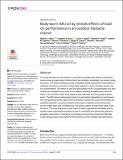| dc.contributor.author | Vitali, Rachel V | |
| dc.contributor.author | Cain, Stephen M | |
| dc.contributor.author | Ojeda, Lauro V | |
| dc.contributor.author | Potter, Michael V | |
| dc.contributor.author | Zaferiou, Antonia M | |
| dc.contributor.author | Davidson, Steven P | |
| dc.contributor.author | Coyne, Megan E | |
| dc.contributor.author | Hancock, Clifford L | |
| dc.contributor.author | Mendoza, Alyssa | |
| dc.contributor.author | Stirling, Leia A | |
| dc.contributor.author | Perkins, Noel C | |
| dc.date.accessioned | 2021-10-27T20:10:44Z | |
| dc.date.available | 2021-10-27T20:10:44Z | |
| dc.date.issued | 2019 | |
| dc.identifier.uri | https://hdl.handle.net/1721.1/135098 | |
| dc.description.abstract | Copyright © This is an open access article, free of all copyright, and may be freely reproduced, distributed, transmitted, modified, built upon, or otherwise used by anyone for any lawful purpose. The work is made available under the Creative Commons CC0 public domain dedication. This study introduces a new method to understand how added load affects human performance across a broad range of athletic tasks (ten obstacles) embedded in an outdoor obstacle course. The method employs an array of wearable inertial measurement units (IMUs) to wirelessly record the movements of major body segments to derive obstacle-specific metrics of performance. The effects of load are demonstrated on (N = 22) participants who each complete the obstacle course under four conditions including unloaded (twice) and with loads of 15% and 30% of their body weight (a total of 88 trials across the group of participants). The IMU-derived performance metrics reveal marked degradations in performance with increasing load across eight of the ten obstacles. Overall, this study demonstrates the significant potential in using this wearable technology to evaluate human performance across multiple tasks and, simultaneously, the adverse effects of body-borne loads on performance. The study addresses a major need of military organizations worldwide that frequently employ standardized obstacle courses to understand how added loads influence warfighter performance. Importantly, the findings and conclusions drawn from IMU data would not be possible using traditional timing metrics used to evaluate task performance. | |
| dc.language.iso | en | |
| dc.publisher | Public Library of Science (PLoS) | |
| dc.relation.isversionof | 10.1371/journal.pone.0214008 | |
| dc.rights | Creative Commons CC0 | |
| dc.rights.uri | https://creativecommons.org/publicdomain/zero/1.0/ | |
| dc.source | PLoS | |
| dc.title | Body-worn IMU array reveals effects of load on performance in an outdoor obstacle course | |
| dc.type | Article | |
| dc.contributor.department | Massachusetts Institute of Technology. Department of Aeronautics and Astronautics | |
| dc.contributor.department | Massachusetts Institute of Technology. Institute for Medical Engineering & Science | |
| dc.relation.journal | PLoS ONE | |
| dc.eprint.version | Final published version | |
| dc.type.uri | http://purl.org/eprint/type/JournalArticle | |
| eprint.status | http://purl.org/eprint/status/PeerReviewed | |
| dc.date.updated | 2019-07-19T16:33:13Z | |
| dspace.orderedauthors | Vitali, RV; Cain, SM; Ojeda, LV; Potter, MV; Zaferiou, AM; Davidson, SP; Coyne, ME; Hancock, CL; Mendoza, A; Stirling, LA; Perkins, NC | |
| dspace.date.submission | 2019-07-19T16:33:15Z | |
| mit.journal.volume | 14 | |
| mit.journal.issue | 3 | |
| mit.metadata.status | Authority Work and Publication Information Needed | |
